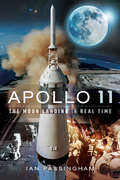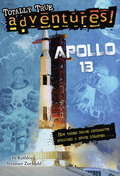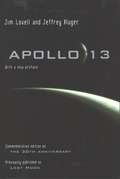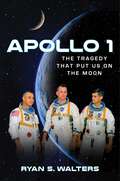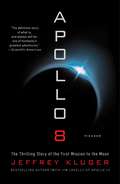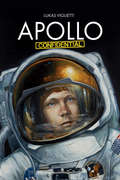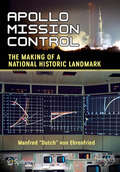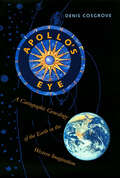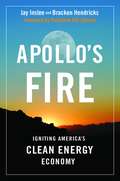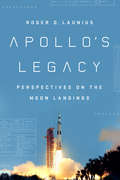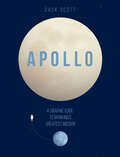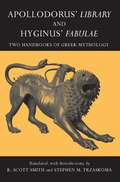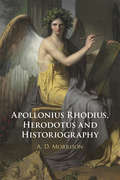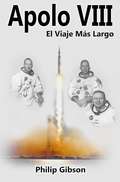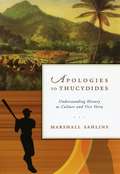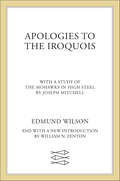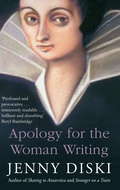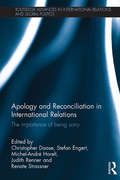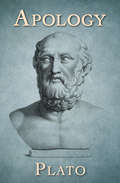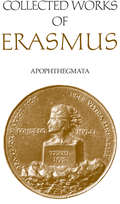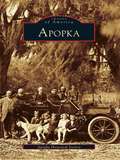- Table View
- List View
Apollo 11: The Moon Landing in Real Time
by Ian PassinghamA day-by-day account of the 1969 Apollo 11 Moon landing—from launch prep to the crews&’ return to Earth—by the author of 66: The World Cup In Real Time. Half a century has passed since arguably the greatest feat of the twentieth century: when Neil Armstrong became the first man to walk on the moon. Apollo 11: The Moon Landing In Real Time brings the mission back to life as never before in a thrilling day-by-day account, exploring everything from the historic flight itself to how the $24-billion space program divided a nation. Journey back in time and feel the excitement build in the days before launch, and then experience the tension of the dramatic lunar landing and the relief of the crew&’s safe return to Earth. This engaging account mixes easily understandable explanations of the groundbreaking technology behind Apollo 11 with entertainment, excitement, and humor in equal measure. Set against a backdrop of the Cold War, race riots, and the Vietnam War, the mission polarized opinion worldwide. Alongside these issues, read long-forgotten tales including how a Chilean lawyer claimed he was the legal owner of the Moon, thousands of people signed up for proposed commercial Moon flights, Hilton revealed plans for a lunar hotel, &“flat Earth&” believers claimed the mission was a hoax, and some scientists feared the astronauts would bring back deadly germs from space which would devastate mankind. &“A most enjoyable read.&” —Quest: The History of Spaceflight Quarterly
Apollo 13 (Totally True Adventures)
by Kathleen Weidner Zoehfeld Wesley LoweCould you survive an outer-space disaster? Aspiring astronauts and young explorers will love this out-of-this-world Totally True Adventure. Astronauts Jim Lovell, Jack Swigert, and Fred Haise blasted off for the Moon on April 11, 1970. But after a disastrous explosion damaged their spacecraft, the three men had only one goal: to get back home safely. This informational text makes space travel exciting and accessible for younger readers and features illustrations, photographs, a map, and additional Story Behind the Story facts. Perfect for readers of the I Survived series and the Who Was series, Totally True Adventures are captivating nonfiction stories with not-to-be-missed bonus content.
Apollo 13: Lost Moon
by Jeffrey Kluger James LovellIn April 1970, during the glory days of the Apollo space program, NASA sent Navy Captain Jim Lovell and two other astronauts on America's fifth mission to the moon. Only fifty-five hours into the flight of Apollo 13, disaster struck: a mysterious explosion rocked the ship, and soon its oxygen and power began draining away. Written with all the color and drama of the best fiction, APOLLO 13 (previously published as Lost Moon) tells the full story of the moon shot that almost ended in catastrophe. Minutes after the explosion, the three astronauts are forced to abandon the main ship for the lunar module, a tiny craft designed to keep two men alive for just two days. As the hours tick away, the narrative shifts from the crippled spacecraft to Mission Control, from engineers searching desperately for a way to fix the ship to Lovell's wife and children praying for his safe return. The entire nation watches as one crisis after another is met and overcome. By the time the ship splashes down in the Pacific, we understand why the heroic effort to rescue Lovell and his crew is considered by many to be NASA's finest hour.Now, thirty years after the launch of the mission, Jim Lovell and coauthor Jeffrey Kluger add a new preface and never-before-seen photographs to Apollo 13. In their preface, they offer an incisive look at America's waxing and waning love affair with space exploration during the past three decades, culminating only recently when the Apollo 13 spacecraft itself, long consigned to an aviation museum outside Paris, was at last returned to its rightful home in the United States. As inspiring today as it was thirty years ago, the story of Apollo 13 is a timeless tribute to the enduring American spirit and sparkling individual heroism.
Apollo 1: The Tragedy That Put Us on the Moon
by Ryan S. WaltersOn January 27, 1967, astronauts Gus Grissom, Ed White, and Roger Chaffee climbed into a new spacecraft perched atop a large Saturn rocket at Kennedy Space Center in Florida for a routine dress rehearsal of their upcoming launch into orbit, then less than a month away. All three astronauts were experienced pilots and had dreams of one day walking on the moon. But little did they know, nor did anyone else, that once they entered the spacecraft that cold winter day they would never leave it alive. The Apollo program would be perilously close to failure before it ever got off the ground. But rather than dooming the space program, this tragedy caused the spacecraft to be completely overhauled, creating a stellar flying machine to achieve the program&’s primary goal: putting man on the moon. Apollo 1 is a candid portrayal of the astronauts, the disaster that killed them, and its aftermath. In it, readers will learn: How the Apollo 1 spacecraft was doomed from the start, with miles of uninsulated wiring and tons of flammable materials in a pure oxygen atmosphere, along with a hatch that wouldn&’t open How, due to political pressure, the government contract to build the Apollo 1 craft went to a bidder with an inferior plan How public opinion polls were beginning to turn against the space program before the tragedy and got much worse after Apollo 1 is about America fulfilling its destiny of man setting foot on the moon. It&’s also about the three American heroes who lost their lives in the tragedy, but whose lives were not lost in vain.
Apollo 8: The Thrilling Story of the First Mission to the Moon
by Jeffrey KlugerThe untold story of the historic voyage to the moon that closed out one of our darkest years with a nearly unimaginable triumphIn August 1968, NASA made a bold decision: in just sixteen weeks, the United States would launch humankind’s first flight to the moon. Only the year before, three astronauts had burned to death in their spacecraft, and since then the Apollo program had suffered one setback after another. Meanwhile, the Russians were winning the space race, the Cold War was getting hotter by the month, and President Kennedy’s promise to put a man on the moon by the end of the decade seemed sure to be broken. But when Frank Borman, Jim Lovell and Bill Anders were summoned to a secret meeting and told of the dangerous mission, they instantly signed on.Written with all the color and verve of the best narrative non-fiction, Apollo 8 takes us from Mission Control to the astronaut’s homes, from the test labs to the launch pad. The race to prepare an untested rocket for an unprecedented journey paves the way for the hair-raising trip to the moon. Then, on Christmas Eve, a nation that has suffered a horrendous year of assassinations and war is heartened by an inspiring message from the trio of astronauts in lunar orbit. And when the mission is over—after the first view of the far side of the moon, the first earth-rise, and the first re-entry through the earth’s atmosphere following a flight to deep space—the impossible dream of walking on the moon suddenly seems within reach. The full story of Apollo 8 has never been told, and only Jeffrey Kluger—Jim Lovell’s co-author on their bestselling book about Apollo 13—can do it justice. Here is the tale of a mission that was both a calculated risk and a wild crapshoot, a stirring account of how three American heroes forever changed our view of the home planet.
Apollo Confidential: Memories of Men On the Moon
by Lukas VigliettiThe inside stories of the Apollo program and the live of astronauts, as told to the author by the men themselves—with a forward by astronaut Charlie Duke. Between 1969 and 1972, twelve people walked on the surface of the Moon. Twelve others flew over its majestic surface. They were the sons of ordinary individuals. But they believed anything was possible―and they proved it to the entire world. Fascinated by these men—heroes such as Alan Shepard, Neil Armstrong, Buzz Aldrin, and many others—airline pilot Lukas Viglietti personally recorded their testimonies, becoming a close friend and confidant to many of them in the process. Now he shares his exclusive and unprecedented insight into their adventures and the Apollo program overall in Apollo Confidential.
Apollo Mission Control: The Making of a National Historic Landmark (Springer Praxis Books)
by Manfred "Dutch" von EhrenfriedThis book describes the history of this now iconic room which represents America’s space program during the Gemini, Apollo, Skylab, Apollo-Soyuz and early Space Shuttle eras. It is now a National Historic Landmark and is being restored to a level which represents the day the flight control teams walked out after the last lunar landing missions. The book is dedicated to the estimated 3,000 men and women who supported the flights and tells the story from their perspective. It describes the rooms of people supporting this control center; those rooms of engineers, analysts and scientists most people never knew about. Some called it a “shrine” and some called it a “cathedral.” Now it will be restored to its former glory and soon thousands will be able to view the place where America flew to the moon.
Apollo in the Age of Aquarius
by Neil M. MaherIn summer 1969, astronauts landed on the moon and hippie hordes descended on Woodstock—two era-defining events that are not entirely coincidental. Neil M. Maher shows how NASA’s celestial aspirations were tethered to terrestrial concerns of the time: the civil rights struggle, the antiwar movement, environmentalism, feminism, and the culture wars.
Apollo's Eye: A Cartographic Genealogy of the Earth in the Western Imagination
by Carmen P. CosgroveWinner of the Association of American Publishers Professional and Scholarly Publishing Award in Geography & Earth Sciences"Earthbound humans are unable to embrace more than a tiny part of the planetary surface. But in their imagination they can grasp the whole of the earth, as a surface or a solid body, to locate it within infinities of space and to communicate and share images of it."—from the Preface Long before we had the ability to photograph the earth from space—to see our planet as it would be seen by the Greek god Apollo—images of the earth as a globe had captured popular imagination. In Apollo's Eye, geographer Denis Cosgrove examines the historical implications for the West of conceiving and representing the earth as a globe: a unified, spherical body. Cosgrove traces how ideas of globalism and globalization have shifted historically in relation to changing images of the earth, from antiquity to the Space Age. He connects the evolving image of a unified globe to politically powerful conceptions of human unity.
Apollo's Eye: A Cartographic Genealogy of the Earth in the Western Imagination
by Denis CosgroveThis award-winning science history explores our evolving image of the globe—and how it has shifted our relationship to the world.Long before we had the ability to photograph the earth from space—to see our planet as it would be seen by the Greek god Apollo—images of the earth as a globe had captured popular imagination. In Apollo’s Eye, geographer Denis Cosgrove examines the historical implications for the West of conceiving and representing the earth as a globe: a unified, spherical body. Cosgrove traces how ideas of globalism and globalization have shifted historically in relation to changing images of the earth, from antiquity to the Space Age. He connects the evolving image of a unified globe to politically powerful conceptions of human unity.Winner of the Association of American Publishers Professional and Scholarly Publishing Award in Geography & Earth Sciences
Apollo's Fire: Igniting America's Clean Energy Economy
by Bracken Hendricks Jay InsleeIn 1961, President John F. Kennedy ignited America's Apollo Project and sparked a revolution in space exploration. Today the New Apollo Energy Project is poised to revolutionize the production of energy and thereby save our planet. The nation that built the world's most powerful rockets, its most advanced computers, and its most sophisticated life support systems is ready to create the world's most powerful solar energy systems, its most advanced wind energy turbines, and its most sophisticated hybrid cars. This will result in nothing less than a second American Revolution. Who are the dreamers in California who believe they can use mirrors and liquid metal to wring more electricity from a ray of sunshine than anyone else on earth can? Who are the innovators who have built a contraption that can turn the energy of a simple wave off the Oregon coast into burnt toast in Idaho? Who are the scientists in Massachusetts who have invented a battery that now runs your hand drill and will soon run your car? Readers will meet them all in this book. They will learn how the new energy economy will grow, the research that is required, and the legislation that must be passed to make the vision a reality. This is a thoughtful, optimistic book, based on sound facts. No one before has tied together the concepts of economic growth and greenhouse gas reductions with such concrete examples. No one has previously told the real stories of the people who are right now on the front lines of the energy revolution. The co-authors, one a U.S. Congressman who is the primary sponsor of the New Apollo Energy Act, and the other the founder of the Apollo Alliance, have joined their experience, expertise, and passion for a clean energy future to lay out the path to stop global warming and gain energy independence.
Apollo's Legacy: Perspectives on the Moon Landings
by Roger D. LauniusAn all-encompassing look at the history and enduring impact of the Apollo space programIn Apollo's Legacy, space historian Roger D. Launius explores the many-faceted stories told about the meaning of the Apollo program and how it forever altered American society. The Apollo missions marked the first time human beings left Earth's orbit and visited another world, and thus they loom large in our collective memory. Many have detailed the exciting events of the Apollo program, but Launius offers unique insight into its legacy as seen through multiple perspectives. He surveys a wide range of viewpoints and narratives, both positive and negative, surrounding the program. These include the argument that Apollo epitomizes American technological--and political--progress; technological and scientific advances garnered from the program; critiques from both sides of the political spectrum about the program's expenses; and even conspiracy theories and denials of the program's very existence. Throughout the book, Launius weaves in stories from important moments in Apollo's history to draw readers into his analysis. Apollo's Legacy is a must-read for space buffs interested in new angles on a beloved cultural moment and those seeking a historic perspective on the Apollo program.
Apollo: A Graphic Guide to Mankind's Greatest Mission
by Zack ScottIllustrations, infographics, and little-known facts about NASA’s Apollo program and the 1969 moon landing.July 20, 1969, marked one of the greatest achievements of mankind—the moon landing. In his infographic-packed book, Apollo: A Graphic Guide to Mankind’s Greatest Mission, Zack Scott recounts the entire journey of the Apollo space program. Unlike previous books on this topic, Apollo illustrates the tiniest details of how man came to walk on the moon, paying particular attention to many of the lesser-known facts about the mission. Artful infographics throughout focus on a wide range of details for space-lovers to obsess over—astronaut weights, mission insignia and spacecraft call signs, fuel consumption stats, splashdown sites around the world, and much, much more. A fresh, lively approach to the subject, Apollo is the perfect combination of science, design, math, and space.
Apollodorus' Library and Hyginus' Fabulae: Two Handbooks of Greek Mythology
by R. Scott Smith Stephen M. TrzaskomaBy offering, for the first time in a single edition, complete English translations of Apollodorus' Library and Hyginus' Fabulae--the two most important surviving "handbooks" of classical mythography--this volume enables readers to compare the two's versions of the most important Greek and Roman myths. A General Introduction sets the Library and Fabulae into the wider context of ancient mythography; introductions to each text discuss in greater detail issues of authorship, aim, and influence. A general index, an index of people and geographic locations, and an index of authors and works cited by the mythographers are also included.
Apollonius Rhodius, Herodotus and Historiography
by A. D. MorrisonThis book examines the Argonautica of Apollonius of Rhodes through one aspect of its relationship with other texts. The particular intertextual relationship examined is that with the Histories of Herodotus, focusing on the presence of the latter text in the former in terms of the poem's employment of characteristics and features of historiographical discourse, narrative structures, presentation and description of characters, aetiology and patterns of explanation, portrayal of ethnic groups, depiction of kingship and tyranny; the relationship between particular passages in both texts is also explored. The consequences for the interpretation of the poem are profound: the Argonautica employs Herodotean historiography as a key intertext in order to manipulate and frustrate the reader's generic expectations for an epic poem and to complicate the relationship between the contemporary Hellenistic Mediterranean (and its kingdoms) and the distant mythological Argonautic past.
Apolo VIII - El viaje más largo
by Philip Gibson Federico Renzi¿Qué hubiera pasado si hubieran existido medios de comunicaciones sociales durante la misión del Apolo 8 a la Luna en el 1968? Esta misión sería el viaje más largo y más peligroso jamás intentado por el hombre. Este relato regresará a todos ustedes atrás en el tiempo pero de una forma creíble directamente dentro de esos seis días tensos y dramáticos del 1968. Es la historia de la primera misión tripulada hacía la Luna relatada en una forma moderna con el sistema de los medios de comunicación sociales de hoy en día, permitiéndonos ser testigos de los dramas de la misión, como si la estuviéramos siguiendo en tiempo real y como si los participantes y observadores estuvieran compartiendo sus pensamientos y acciones con nosotros directamente. En diciembre de 1968, quedaba mucho por conocer. Sería el primer lanzamiento tripulado utilizando el gigantesco cohete Saturno V y si todo iba a salir bien ese mismo cohete los regresaría a la órbita de la Tierra. ¿Serían los seres humanos capaces de sobrevivir atravesando los cinturones de radiación de Van Allen presente entre la Tierra y Luna? ¿Qué pasaría a los astronautas en el momento de pasar alrededor de la cara oculta de la a la luna fuera del contacto con la Tierra? ¿Podrá el único motor lograr impulsar la nave espacial fuera de la órbita lunar en un viaje de regreso hacía la Tierra como todos se esperan? ¿Tendrá éxito la primera recuperación nocturna de una nave espacial en el océano Pacífico? Si la misión Apolo 8 tendrá éxito, las astronautas a bordo se convertirían en los primeros seres humanos a viajar tan lejos y tan increíblemente, increíblemente rápido. Serían los primeros en salir de la esfera de influencia de la Tierra y los primeros en ver todo el planeta Tierra desde el espacio. Ellos serían los primeros en orbitar alrededor de la Luna, los primeros en poner los ojos en la cara oculta de la Luna y los primeros seres humanos a presenciar la esp
Apologies to Thucydides: Understanding History As Culture and Vice Versa
by Marshall SahlinsThucydides' classic work on the history of the Peloponnesian War is the root of Western conceptions of history--including the idea that Western history is the foundation of everyone else's. Here, Marshall Sahlins takes on Thucydides and the conceptions of history he wrought with a groundbreaking new book that shows what a difference an anthropological concept of culture can make to the writing of history. Sahlins begins by confronting Thucydides' account of the Peloponnesian War with an analogous "Polynesian War," the fight for the domination of the Fiji Islands (1843-55) between a great sea power (like Athens) and a great land power (like Sparta). Sahlins draws parallels between the conflicts with an eye to their respective systems of power and sovereignty as well as to Thucydides' alternation between individual (Pericles, Themistocles) and collective (the Athenians, the Spartans) actors in the making of history. Characteristic of most histories ever written, this alternation between the agency of "Great Men" and collective entities leads Sahlins to a series of incisive analyses ranging in subject matter from Bobby Thomson's "shot heard round the world" for the 1951 Giants to the history-making of Napoleon and certain divine kings to the brouhaha over Elián Gonzalez. Finally, again departing from Thucydides, Sahlins considers the relationship between cultural order and historical contingency through the recounting of a certain royal assassination that changed the course of Fijian history, a story of fratricide and war worthy of Shakespeare. In this most convincing presentation yet of his influential theory of culture, Sahlins experiments with techniques for mixing rich narrative with cultural explication in the hope of doing justice at once to the actions of persons and the customs of people. And he demonstrates the necessity of taking culture into account in the creation of history--with apologies to Thucydides, who too often did not.
Apologies to the Iroquois
by Edmund WilsonEdmund Wilson at his most lucid and thought-provoking, traveling off his usual literary track to deliver this engrossing account of life among the Iroquois in all its facets.
Apologies to the Iroquois (The\iroquois And Their Neighbors Ser.)
by Edmund WilsonEdmund Wilson's personal and informative study on the plight of the Native American Indians, Apologies to the IroquoisAs Wilson writes, “[In August 1975] I discovered in the New YorkTimes what seemed to me a very queer story. A band of Mohawk Indians, under the leadership of a chief called Standing Arrow, had moved in on some land on Schoharie Creek, a little river that flows into the Mohawk not far from Amsterdam, New York, and established a settlement there. Their claim was that the land they were occupying had been assigned them by the United States in a treaty of 1784. The Times ran a map of the tract which had at that time been recognized by our government as the territory of the Iroquois people, who included the Mohawks, the Senecas, the Onondagas, the Oneidas, the Cayugas and the Tuscaroras, and were known as the Six Nations. The tract was sixty miles wide, and it extended almost from Buffalo to Albany. "I had already known about this agreement as the Treaty of Fort Stanwix (now Rome, New York), which had first made it possible for white people to settle in upper New York State without danger of molestation by its original inhabitants; but I had not known what the terms of this treaty were, and I was surprised to discover that my property, acquired at the end of the eighteenth century by the family from which it had come to me, seemed to lie either inside or just outside the northern boundary. Having thus been brought to realize my ignorance of our local relations with the Indians and continuing to read in the papers of the insistence of Standing Arrow that the Mohawks had some legal right to the land on which they were camping, I paid a visit, in the middle of October, to their village on Schoharie Creek . . . .”
Apology For The Woman Writing
by Jenny DiskiMarie de Gournay was eighteen when she read, and was overwhelmed by, the essays of the French philosopher Montaigne. She had to be revived with hellebore. When she finally met Montaigne, she stabbed herself with a hairpin until the blood ran in order to show her devotion. He made her his adopted daughter for the two months they knew each other. He died four years later, after which, though scorned by intellectuals, she became his editor. Jenny Diski engages with this passionate and confused relationship between 'father and daughter', old writer/young acolyte, possible lovers, using both their voices. Much of their story is about absence of the people they love. In Jenny Diski's hands it becomes a fascinating tale.
Apology For The Woman Writing
by Jenny DiskiMarie de Gournay was eighteen when she read, and was overwhelmed by, the essays of the French philosopher Montaigne. She had to be revived with hellebore. When she finally met Montaigne, she stabbed herself with a hairpin until the blood ran in order to show her devotion. He made her his adopted daughter for the two months they knew each other. He died four years later, after which, though scorned by intellectuals, she became his editor. Jenny Diski engages with this passionate and confused relationship between 'father and daughter', old writer/young acolyte, possible lovers, using both their voices. Much of their story is about absence of the people they love. In Jenny Diski's hands it becomes a fascinating tale.
Apology and Reconciliation in International Relations: The Importance of Being Sorry (Routledge Advances in International Relations and Global Politics)
by Judith Renner Christopher Daase Stefan Engert Michel-André Horelt Renate StrassnerThis book looks into the role and effects of public apologies in international relations. It focuses on two major questions - why and when do states issue apologies for historic crimes and how and under what conditions are these apologies successful in remedying conflictive relationships? In recent years, we have witnessed an unseen popularity of apologies, with numerous politicians, managers and clergymen being eager to apologise and atone for the wrong-doings of their countries or institutions. Public apologies, thus, are a new and highly interesting, while nevertheless still puzzling phenomenon, the precise role and meaning of which in international politics remains to be explored. This book sets out to do exactly this. Focusing in particular on state apologies, it assembles twelve detailed empirical case studies which deal with the two questions raised above. In the first part, the case studies reconstruct the processes in which state representatives react to calls for public atonement, and in the second part the case studies explore the reactions to the apology and evaluate signs for its success or failure. All case studies are based on a theoretical framework which is outlined in the introduction to the book and helps develop tentative assumptions about the emergence and the effects of state apologies, drawing on different strands of literature, such as political science, philosophy, sociology or psychology. This work will be of great interest to students and scholars of conflict reconciliation, international relations and transitional justice.
Apology: Crito And Phaedo Of Socrates - Scholar's Choice Edition
by PlatoSocrates defends himself in court in this resounding speech, recounted firsthand by one of history&’s greatest philosophers. Plato&’s Apology is an account of the speech Socrates makes at the Athenian trial in which he is charged with not accepting the gods recognized by the state, inventing new deities, and corrupting the youth of Athens. Recounted by Plato, Socrates&’s speech is a rousing examination of integrity, wisdom, and the role of a philosopher. It is filled with wit, intelligence, and lessons that remain relevant today.
Apophthegmata
by Elaine Fantham Desiderius Erasmus Betty I. Knott-SharpeAssembled for the young Prince William of Cleves, Erasmus' Apophthegmata consists of thousands of sayings and anecdotes collected from Greek and Latin literature for the moral education of the future ruler. Betty I. Knott and Elaine Fantham's annotated translation of the aphorisms and Erasmus' commentary on them makes this once popular literary and educational text accessible to modern audiences. The introduction discusses the origins of the Apophthegmata, the contents of the collection, and Erasmus' sources.
Apopka
by Apopka Historical SocietyApopka, Florida, started out as a place once dubbed "Big Potato" by the Native Americans of the area and was formerly known as the "Fern City," but it is now most notably considered the "Indoor Foliage Capitol of the World." Once-thriving fragrant citrus groves have been replaced by climate-controlled greenhouses and fields of landscaped nurseries and subdivisions. The second largest city in Orange County, Apopka is located in the northwest region of the county. It functions today as a bedroom community for Orlando and boasts the history of a community filled with a deep sense of pride.
